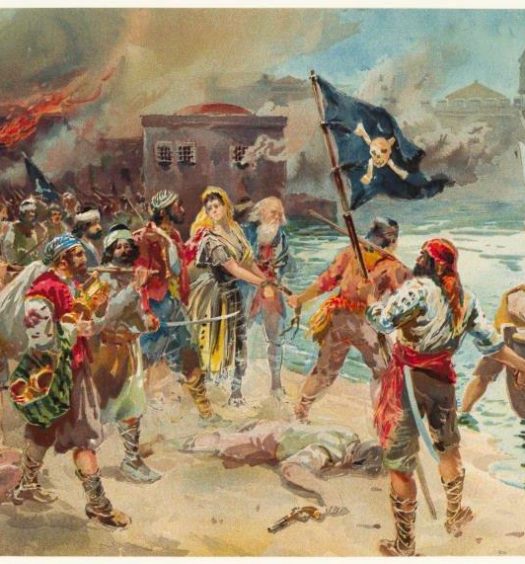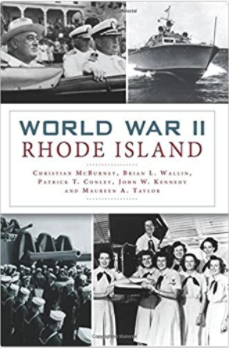In the summer of 2011 I received an excited phone call from my sister, Jane Buffum. She said: “Charlie found it! He found it!” I said: “Found what?” “The Revenge, The Revenge” she said. “Revenging whom? I said. It turned out to be Oliver Hazard Perry’s ship Revenge. I did not know he had a ship called Revenge, but every Rhode Islander knows (or should know) the name Oliver Hazard Perry. He was the naval hero who won the battle of Lake Erie against the British in the war of 1812. Perry is important to me because he lived in my town of Newport and is buried here at Island Cemetery. There is a statue of him in Eisenhower Park in Newport. (Perry was born in South Kingstown, but his family moved to Newport when he was a boy around 1793).
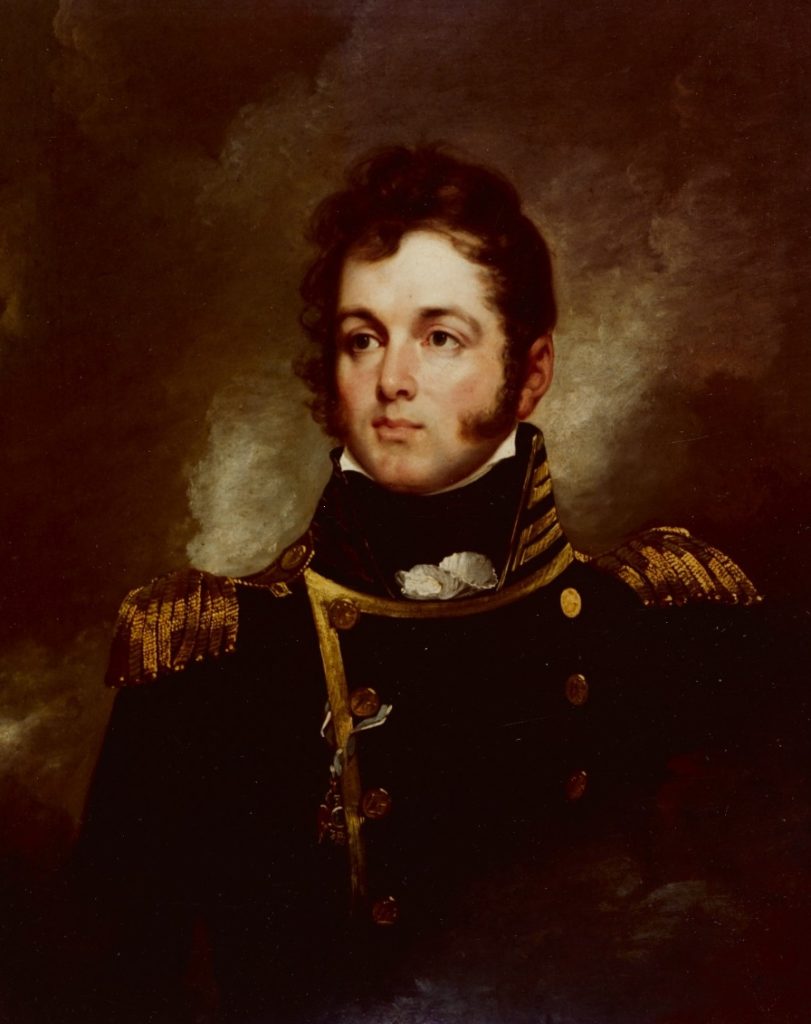
Oliver Hazard Perry, a portrait by Edward L. Mooney, after John Wesley Jarvis (1839) (Naval History and Heritage Command)
I needed to talk to my nephew, Charlie Buffum, to get the complete story. My sister lives in Avondale, located just north of Watch Hill and next to the Pawcatuck River. Several years ago Jane gave her son Charlie a book titled Shipwrecks on the Shores of Westerly. Charlie was fascinated by the account of the seventy-foot, fourteen-gun schooner USS Revenge that struck a reef off Watch Hill Point. Also interesting, its captain, Oliver Hazard Perry, was Charlie’s third cousin, five times removed. Perry had also spent fourteen months supervising the construction of gunboats on the Pawcatuck River near where Charlie grew up.
Charlie often thought that he should go out and take a look at the wreck site and see if anything was left. Diving is an amateur sport to him; he is far from being a professional diver. The area he wanted to dive is dangerous as there is a two to four knot current allowing a diver to dive only during slack tide, giving the diver just thirty minutes under water before the tide turns.
One former light house keeper at Watch Hill said he witnessed forty-five wrecks on the reefs in his twenty years of service. I personally watched the eighty-foot power yacht Carmac, owned by the 3M Company, being torn apart by the seas on the reef at Watch Hill Point in September 1953.
I researched what happened to Revenge. The fourteen-gun USS Revenge was the first ship Perry commanded when he was only a twenty-six year old naval lieutenant. The schooner was built in Baltimore in 1805, and Perry assumed command of it in 1809. After sailing the seas for a year, the ship returned to Newport. In the winter of 1810, Perry was ordered to survey the harbors of Newport, New London, and Gardiner’s Bay, Long Island. In December 1810 he was ordered to take the schooner and make a large scale chart of safe anchorages between Newport and New Haven. His career was almost ruined as a result of this order.
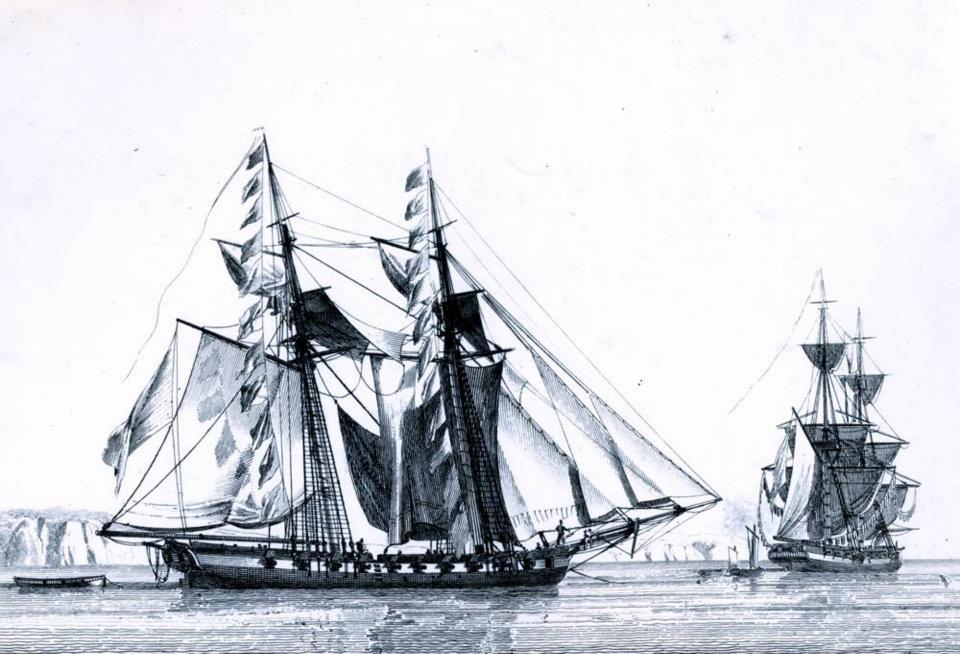
Oliver Hazard Perry’s schooner Revenge, wrecked on the rocks off Watch Hill in 1811, may have looked like the 12-gun schooner Enterprise shown here, which was originally built in Baltimore in 1799 (Naval History and Heritage Command)
After a long wait for foggy weather to clear, Perry was finally able to set sail from Newport at midnight on January 8, 1811. He wanted to pass through the Watch Hill Passage and avoid the dangerous currents at the Race between Fisher’s Island and Long Island in daylight. When his schooner had been underway for an hour, the fog set in again. Perry asked his pilot, Peter Daggett, if they should continue. Daggett answered in the affirmative. Perry had confidence in Daggett as he was a respected sailing master and pilot. Perry ordered an anchor to be ready to be let go if the pilot had any doubt. Daggett again assured him a safe return. At 6 a.m. Revenge passed Point Judith; the next potentially hazardous headland was Watch Hill thirty miles due west. Because of the fog Revenge was steered slightly off shore for safety. As Revenge was making only three knots with a two-knot favorable current it would take six hours to make the Watch Hill passage. Perry, feeling comfortable with that, went below to get some much needed sleep.
At 9 a.m., Perry, still below decks, heard the leadsman, taking soundings in the fog report ten fathoms. The previous soundings were twelve to fourteen. He immediately went on deck and ordered the helm to starboard. Revenge had encountered heavy fog “so thick as to envelop all on board Revenge in almost total darkness, and was accompanied with a heavy swell.” Perry saw that the water was shoaling quickly from five, to two-and-a-half fathoms. He immediately ordered the anchor to be let go, but at the same instant the stern struck the reef. The anchor had grabbed and spun the vessel around allowing her to sail off the reef under a very light breeze. Perry ordered the sails to be trimmed and ordered the anchor cable cut. She moved a short distance ahead but the wind had dropped and the swells and the strong flood tide swung her bow on to the reef. As it was high tide the chance of saving the vessel was now very slim.
The boats were sent out to sound the depth. A kedge with hawser was set in the deepest water and pulled tight. Eight of the guns were thrown overboard along with other heavy articles. The pumps were manned continuously, and the crew bailed with buckets while distress signal guns were fired. The schooner pounded heavily on the reef and was soon leaking badly. During this time, someone had cut the cable of the anchor, causing the ship to move further onto the reef. Perry ordered the mainmast cut down and the foremast soon after. In just twenty minutes after she struck, her seams opened in two places; there was no hope for saving her. Now the concern was to get all the men off the doomed ship to the safety of the shore.
The signal guns brought several boats from shore, but because of the swells, it was difficult to approach the wreck. The wind had picked up and the surf was nearly breaking over the vessel, which was fast going to pieces. The officers and men were able to lower themselves by ropes over the stern into the schooner’s small boats between swells. Perry was the last to leave. By sunset, all 78 hands had made it safely to shore, along with the sails, rigging, and small arms.
The launches of the frigates USS President and USS Constitution had arrived during the night from New London. The next morning they watched the deck and bulwarks float off the reef. With the aid of the frigates, Perry went back to the rest of the wreck and took it in tow in order to beach it on Fisher’s Island. A smack, hired by the commodore, also assisted in the tow. The remainder of the schooner’s six light carronades and other armament were taken off and placed in the launches. During this time the weather had changed to a hard blow of cold air and sleet arriving from the Northeast, causing high surf. When close to the island, the hawser attached to the wreck parted and the violence of the sea breaking over the vessel made it impossible to reattach it. The wreck was abandoned and the smack and launches ran into New London to take refuge from the storm.
In August of 2005, Charlie Buffum and his friend, Craig Harger, took their diving gear and an underwater metal detector aboard the Blue Moon and anchored it near the Watch Hill Reef. Diving over the next two days, they found nothing. They were discouraged that the metal detector had not even located any old fishhooks or bottle caps There were many false hits, and difficult conditions did not help.
During the dive on the third day, Charlie recalled, “We were like little school boys going around seeing nothing, when all of a sudden the meter on the metal detector hit ten on the scale.” Charlie yelled into his mask, “We found it! Look at that! We found it!” Hager could see Charlie’s eyes bulge out. Following Charlie’s eyes, there it was, under barnacles, sea grass, and star fish: a cannon. It was actually a carronade, a small cannon, used from the 1770s until the mid-1800s that would have been mounted on the top deck of a warship. It was the type of cannon that was thrown overboard from Revenge.
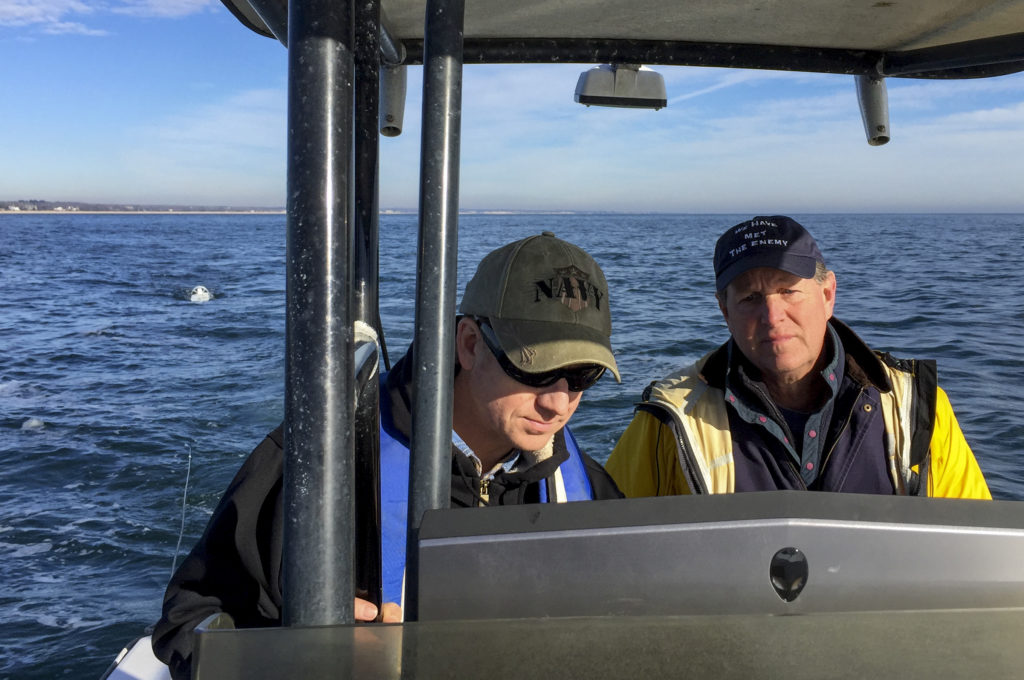
Charlie Buffum on the right, and an underwater archeologist with the Naval History and Heritage Command on the left, survey the potential wreck site of the USS Revenge in shallow waters off the coast of Watch Hill, December 7, 2015 (Naval History and Heritage Command)
Then Charlie and Craig found a second one—in less than fifteen feet of water! Harger, swimming back to find a dive-flag to mark the finding, bumped into a large object and discovered it was yet another carronade. Charlie and Craig agreed to keep their find a secret along with a third friend, Mike Fournier, who joined them later. They made at least one hundred dives at this spot over the next few years. There were many false hits, but in 2007, the team found six more carronades, canister shot, an anchor, ballast bar and other metallic objects. They decided to share their secret on January 9, 2011, as it was the two hundredth anniversary to the day that Revenge was wrecked. The find made some national news outlets, and was a pretty big deal here in Rhode Island for a time.
Charlie and his two friends were now concerned that as a result of going public, other divers might try to remove objects from the site, which would be a violation of federal maritime law. Although the objects they found are in only fifteen feet of water, the area is difficult to dive into because of currents and heavy kelp covers the site. They hoped that would keep other divers away.
Charlie and his two friends are 99% positive that the artifacts they found are from Revenge, as no other war ship was known to have sunk on this reef. The only way to prove their theory is to have the items recovered and analyzed for markings. The U.S. Navy has the right to salvage its warships so they contacted the Navy History and Heritage Command, which would oversee such operations.
Here is what the Naval History and Heritage Command’s website has about their search:
Their discovery (by Buffum and Harger) prompted an investigation of the site with Naval History and Heritage Command’s (NHHC) Underwater Archaeology Branch (UAB), in partnership with Woods Hole Oceanographic Institution, Naval Undersea Warfare Center Engineering and Diving Support Unit, along with the discoverers. On 7–9 February 2012, the site was surveyed using AUV to collect side scan sonar, multibeam echosounder, and video data. Working closely with the U.S. Navy, Buffum and Harger have continued to protect the wreck site and its coordinates, and assisted with ongoing investigations into whether the site is in fact the resting place of Revenge.
In December of 2015, NHHC UAB archaeologists George Schwarz, Ph.D., Blair Atcheson, and Heather Brown joined Buffum, Harger, and Fournier to visit the site for examination. The objective of the project was to collect magnetometer data over the site tentatively identified Perry’s lost schooner to get an idea of the extent of the debris. In May of 2017, NHHC’s UAB partnered with divers from the Naval Undersea Warfare Center (NUWC) and Explosive Ordnance Disposal Mobile Unit 12 Detachment Newport, Rhode Island, to document the provenance of the cannon and recover one gun for conservation, analysis, and eventual public display. It was hoped that the cannon, believed to be a six-pounder, would support identification of the wreck as Revenge and provide more information on the site. While it is consistent with an American-made Armstrong-pattern 6-pounder of the period, no markings were found on the cannon after the concretion layer was removed.
In September 2018, NHHC partnered again with NUWC and the site discoverers (Buffum and Harger) to continue the archeological investigation of the wreck. Rough seas and tidal cycles limited the amount of time on site, but the dive team continued mapping the site, recording an anchor of unknown origin south of the main wreckage, and documenting and recovering the carronade. The carronade was transported to the Washington Navy Yard where it will undergo a similar conservation process as the 6-pdr recovered in 2017.
As with the loss of any Navy ship, a court of inquiry took place shortly after the incident. A jury of Perry’s Navy peers exonerated Perry for the loss of Revenge. The pilot, Peter Daggett, received all the blame. Later in 1811, Perry married Elizabeth Champlin Mason in Newport. Although Perry survived several fierce naval battles and even a pistol duel, in 1819 he succumbed to yellow fever at the age of 34 and is buried in Newport’s Island Cemetery. He will always be known for winning the Battle of Lake Erie and for his famous battle report: “We have met the enemy and they are ours; two ships, two brigs, one schooner, and one sloop.” Despite his young age, Perry rose to the rank of commodore.
[Banner image: Oliver Hazard Perry’s schooner Revenge, wrecked on the rocks off Watch Hill in 1811, may have looked like the 12-gun schooner Enterprise shown here, which was originally built in Baltimore in 1799 (Naval History and Heritage Command)]
Bibliography:
Interviews by the author with Charlie Buffum.
Carter, Margaret W., Shipwrecks on the Shores of Westerly (Westerly: David G. Carter, 1973), republished by Thomas Barnes Carter and Sarah Ann Carter, 2011.
Mackenzie, Alexander Slidell, The Life of Commodore Oliver Hazard Perry (1840), vol. I, 67-73.
McBurney, Christian, “Top 20 Greatest Rhode Islanders of All Time: Counting Down from Number 5 to 1,” www.smallstatebighistory.com (go to Archives and search for Oliver Hazard Perry).
Naval History and Heritage Command website, United States Schooner Revenge, accessed March 2019: https://www.history.navy.mil/content/history/nhhc/research/underwater-archaeology/sites-and-projects/ship-wrecksites/uss-revenge.html Or go to www.history.navy.mil and search for “USS Revenge>\.” There is also an article on the 2015 search that can be accessed using the same search term. For another article just on Revenge, search for the term “Revenge III”).
See also Jenney, Jim, “Mariners Beware – Shipwrecks in Rhode Island – Watch Hill,” in The Online Review of Rhode Island History, March 16, 2019, at http://smallstatebighistory.com/mariners-beware-shipwrecks-in-rhode-island-watch-hill/



